An Ethiopian, a Palm Civet Cat and a Judge Walk into a Brew Bar...
It is a funny feeling to come upon one's preferences quite suddenly, as if simultaneously running into an old friend around a street corner and identifying him for the first time.
At first cupping, the Ethiopian Djimmah stood head and shoulders above a rather earthy Sumatran Madheling and dependable Brazilian Santos although the Japanese neighbour preferred the Sumatran.
Then at Tea & Coffee World Cup Singapore 2011 (Singapore's Suntec Convention Centre), while others had photos taken with towering shiny Probat roasters and coffee industry stars, I stood gobsmacked at this sight:
It shouldn't have come as too much of a surprise since Howard Schultz's re-education (or good marketing story) and the company's monopoly on Clover machines has already been widely reported. The Starbucks booth, fooling no one with their new nameless logos, was serving a mix of "aged Sumatran" and "sun-dried Ethiopian" in their 40th Anniversary Tribute Blend - note ubiquitous (and very useful until someone manufactures something better) Hario Buono drip kettle, Melitta single-serve drip filter holders on a rack (the Marina Square branch was selling the filter holders for S$8.90). Somewhat fragrant, safe and clean, just not terribly attention-retaining.
What left a very long and pleasant after-taste that compelled me to look for more of the same the next day, was the Ethiopian Sidamo offered by Oriole Coffee Roasters just across from the Starbucks booth.They'd put the beans in their spanking new La Marzocco Strada (Singapore's first say some), despite crowd-opinion about putting Ethiopians only in filters and siphons, and what a good call - in an espresso, the florals and citrus were squeezed into a nice round body. The obvious sweetness of the coffee juice was different from the sweetness of steamed milk, so when paired with dairy, the drink teetered on the edge of too-much-of-two-good-things. Still, a lovely cup. There are no plans to serve the Sidamo on the machine at the Oriole Cafe & Bar for now...if only we had the taste/olfactory equivalent of a snapshot of this one-off.
(We realised later that Romeo Alfen might have been practising for the finals of the Singapore National Barista Championships 2011. The next day, he based his routine on that very same single origin, 80% roasted to half-city on the Diedrich and the rest roasted full-city, rested for 10 days.)(Ryan Kieran Tan of Papa Palheta eventually swept the top prize for both the Greenfields Latte Art Challenge as well as the Singapore National Barista Championships.)
Since there weren't any packs of the Sidamo to be had from Oriole Coffee Roasters, settled for an Ethiopian Harrar instead from the Yirgacheffe (and?) Harrar region. It was a mixed heirloom varietal, dry-processed. Oriole's tasting notes enthused about floral notes and bergamot, blueberry flavours, smooth and clean acidity, balance of fruit notes and sweetness. Ethiopia heirloom varietals from the wild forests are said to resemble the typicas from Yemen which were brought to Indonesia and later Latin America. Stumptown Coffee Roasters say that heirlooms produce some of the most coveted flavours in the world that, ranging from floral (jasmine in particular), to sweetly citric (distinct lemon), to chocolate, to Assam tea, and to wild berries. This bag from Oriole had a lovely floral aftertaste 5 days from roasting - coffee breath begone! and was exceptionally good with buttery Danish biscuits.
Brew method: Hario V60
Grind size: between 2-3 notches from zero on the Hario Skerton
Dose weight: 13g
Brew water temperature: 93 degrees celcius
Brew water weight: 161g
Time from roast: 5 days
The Ethiopian Yirgacheffe from Papa Palheta, wet processed, city to full-city roast, S$15.00 for 250g. Papa P's tasting notes described cane sugar sweetness with honey and floral flavours.
Brew method: Hario V60 drip filter pourover
Dose weight: 13g
Brew water weight: whatever it takes to fill the glass
Brew water temperature: 93 degrees celcius
Yirgacheffe is grown around the town of Yirgacheffe in the middle of Sidamo at around 1800-2000 meter altitude (on average). Yirgacheffe is wet processed and generally known for giving a clean cup with powerful floral and fruit notes. Some have described a good cup as "beginning with sublime aromas of sweet sugary honey and hints of cedar and raisin, it is then followed by a well balanced floral acidity in the cup. The flavours are very up front and straight away there is berry, citrus and soft cocoa with a subtle underlining of Mediterranean herbs. These flavours are on the bright side but they bring a well toned smoothness and medium body to the pallet, and as the cup cools the aromatic herbs come to the forefront."
Ethiopia is known more generally for its famines and internal strife (and attendant distasteful jokes) than the quality of its coffee. But the internets point to Ethiopia as the birthplace of coffee, the Motherland of the Arabica Bean, the Motherlode of Black Gold. It is the currently the seventh largest producer in the world, with tens of thousands offarms gardens in the regions of Harar, Sidamo, Yirgacheffe, Limmu and Djimmah. Several hundred thousands of heirloom varietals also grow indigenously and abundantly in the wild forests of the country. ("Wild forests" may not mean wild forests, really.)
Sadly, little can be known about this treasure trove of beans because of the centralisation of all coffee exports through the Ethiopia Commodity Exchange (ECX) in 2008. Lots are thrown together and thus anonymised upon arrival at the ECX so accurate information of the precise traceability of coffees is impossible to be had. The pooled beans would also obviously be rather hit-and-miss, the only identifier being the region and not a specific farm or altitude or varietal. Cupping then is very important to separate the wheat from the chaff. Cup quality from bags labelled, for example, "Yirgacheffe", might vary wildly.
Last year however, the ECX set up the Ethiopian Direct Specialty Trade (DST) auction which allowed smaller lots to be auctioned off, erm, directly. Read Tim (Counter Culture)'s report here, Stephen Vick's report here, Max Nicholas-Fulmer's account here. Doesn't seem too different from Willem Boot's ECAFE Foundation from 2005, except that the government gets a cut - in 1998, all coffee had to be sold through a handful of government-sanctioned exporters. Later, at the end of decades of communist rule and civil strife, unions were organised by farmers and these by-passed the government system.
Several American specialty coffee have managed to go to source for cupping and a look-around:
Counter Culture
Sweet Maria
Daniel Humphries
Stumptown Coffee Roasters
David Pohl for Equator Coffees & Teas
Get me on the Ethiopian Cupping Caravan already.

But they could not bring the beans out with them. Ethiopian coffee is hard work not only because of the roadblock that is the ECX, but getting coffee physically out of the country is in itself an issue. Michaele Weismann's God In A Cup from 2008 reports of several roasters asking Menno Simons of Trabocca BV, a sourcer of organic coffees in Africa, for their beans. The late shipments were not his fault - coffee export defaulting continued to be an issue in 2010. And there was the bizarre disappearance of 9 million kilogrammes of coffee on route for export.
Because we live at a time when it's not even politically-correct to speak of the white man's burden, though any discussion concerning a developing country's exports necessarily requires ethical-soothers for importers in developed countries - the campaigns behind headings like "How can Ethiopia's coffee farmers get more from your £2 latte?" appeal to such tender social consciences. But the issue with this, as with all other foreign intervention, is whether such programmes really work. In Weismann's book, Peter Giuliano explained that when the coffee unions got coffees certified as organic and Fair Trade, big money started pouring in. But corruption and mismanagement was not far behind and farmers were not paid for their crop despite co-operatives being paid. Fair trade has also been accused of forcing farmers into co-operatives, requiring them to borrow money to pay certification fees, and basically failing to understand cultural or country-specific realities. Hopefully, this will not be on the scale of the boo-boos of the Green Revolution which led to deforestation in Africa. The good thing about Fair Trade though is that they provide a safety net on falling prices.
With Ethiopia, there is also the usual suspicion of the activity of large multinationals, specifically, Starbucks opposing Ethiopia's attempt to trademark geographical indicators Sidamo and Harar. I'd like some further questions to be asked - why trademark rather than certificate of origin? Who exactly will be the trademark owner - Meles Zenawi? Does this mean that if farmers from Sidamo or Harar sell their crop directly to specialty coffee roasters, they cannot imprint the regional appellation without paying the trademark owner?
Perhaps direct trade, a la Intelligentsia, might be the way forward?
In the eyes of the, erm, tongue, the civet cat poo coffees have now been knocked down to second place by the Ethiopians. But I still sought them out. Previously, I'd gotten my fix of cà phê Chồn during regular visits to Ho Chi Minh City (where there were rumours that hydrogen chloride was used instead of the digestive tract of relatives of the mongoose). At Tea & Coffee World Cup Singapore 2011, JJ Royal offered brewed kopi luwak from flasks - a good way to showcase its unique flavour and didn't leave room for error for the in-house barista. Bote Central's coffee alamid booth from Philippines pulled a rather harsh espresso on my turn so although the aroma of the bean was in present, the cup itself wasn't terribly pleasant which was a pity.
All contemporary coffee conversations appear to revolve around the variables that make up a good cup (there are also conversations about post-postmodernism, critical theory and the objectivity of a quality brew). Other than the bean itself - its varietal, the region and altitude at which it was grown, the influence of the weather and soil on its growth etc, there's also how the bean is processed - the washing and drying and milling and storage,
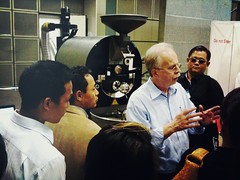
Probat roasting workshop, because everyone's a micro-roaster
then the roasting - from light, cinnamon to full city to continental to, oops, charcoal,
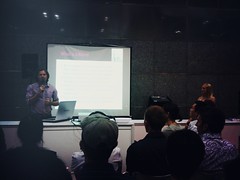
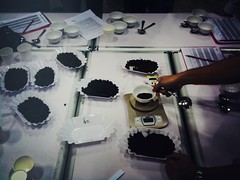
Peter and Penny Wolff from Wolff Coffee Roasters conducting the blending workshop
then, if not serving single estate or single origin, there's the blending of the beans. (The green beans can also blended before roasting.)
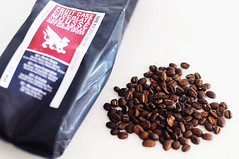
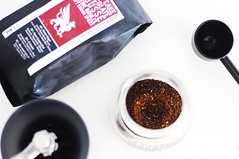

Square Mile Coffee Roasters' Winter Espresso + Hario Skerton grinder + Hario Buono drip kettle + Aeropress
It was really interesting to taste how the Ethiopian Yirgacheffe (albeit an identifiable from the Hama Cooperative in Kocherie) hung out with the Monte Alegre from Sul de Minas Gerais in Brazil, the El Guabo from San Ignacio, Cajamarca, Peru and random micromill blend from Tarrazu, Costa Rica in Square Mile Coffee Roasters' Winter Espresso blend.
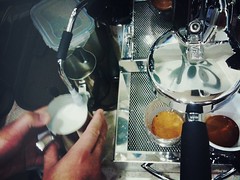
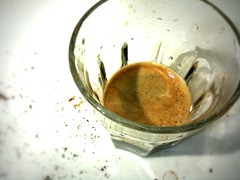
Highlander Coffee's Supremo blend on the machine at 49 Kampong Bahru Road vs on the mypressi TWIST at home
Served single origin or in a blend, the coffee must then be extracted by different methods (drip, siphon, Aeropress, espresso machine etc). The grind of the bean, the water temperature, the water to coffee ratio, extraction yield, total dissolved solids, pressure profiling (for espresso) etc all contribute to the characteristics of the drink.
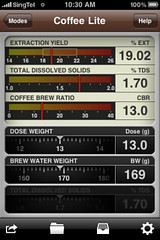
So of course there is an iPhone app for this - MoJotoGo - even the Coffee Lite version has been useful.

Soho 7 Cafe & Bistro, 36 Armenian Street, along Loke Yew Street
Then, there is the skill of the barista, especially where coupling with dairy is involved. The same National Heritage blend, not more than three days old, also accompanied by the Best Ever Burger at SoHo7 Cafe & Bistro,
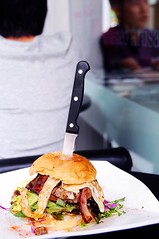
was delicious in a latte made by Swee Sim, a vast difference from the previous "flat white" by a different person.
Great progress has been made in articulating what can be known about coffee, yet there there is still so much more to understand which National Geographic et al cannot hope to plumb the depths of (and it is merely one in millions of plants in the world). This is nothing compared to the wonder of God working in the Book of Judges, but without fair trade or direct trade considerations. Afterall, one would expect the God who made the coffea family, to do even more amazing things with his people.
The details of his various rescues of the people of Israel are far more fascinating than the refractometer readings of a good cup of the mythical Hacienda La Esmeralda Special. So far, we've had Ehud the leftie with a two-edged dagger in the hideously fat Eglon's roof chamber, Shamgar with an ox-goad, and Jael the non-Israelite woman with a tent-peg in her own tent (read Judges 3 - 5 - absolutely riverting).
People have tried to apply these accounts by saying that lack of gifting in some area should not dissuade one from serving in that area. This seems a nonsense since (1) elsewhere we are told that God gives us all unique ways of serving the body (so an eye should not wish to be a thumb when it is obviously an instrument of sight), and (2) this is really about the glory going to no one but God - whereas hunky heroes and the latest in iron chariot technology would induce little more than neighbour envy and self-improvement workshops, salvation via such random judges can mean that only God is at work. This looked forward to the day a son of a carpenter (though not fathered by him) would wrought a rescue to end all rescues with no other weapon but his own perfect obedience and his life blood.
Will we trust and obey him? Or will we, like the stubborn Israelites call God's judgement upon ourselves?
(Another surprising discovery: whereas the previous assumption was that I was immune to the effects of caffeine, it appears now that coffee has a soporific effect. After ten espressos/espresso-based drinks, the struggle to keep awake is almost overwhelming. Apparently, this is common amongst ADD/ADHD folk and caffeine has in fact been recommended by everyoneisanexpertontheinternet as an alternative to Ritalin. So much for the efficacy of that morning cup.
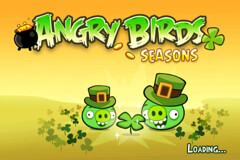
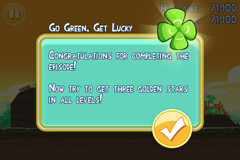
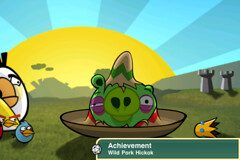





Angry Birds - Seasons: St Patrick's Day, Ham 'Em High, Rio (love the programming of the monkeys)
Video/computer/iPhone games are supposed to have the same effect. Haha...wheeeeeeeeeee!)
At first cupping, the Ethiopian Djimmah stood head and shoulders above a rather earthy Sumatran Madheling and dependable Brazilian Santos although the Japanese neighbour preferred the Sumatran.
Then at Tea & Coffee World Cup Singapore 2011 (Singapore's Suntec Convention Centre), while others had photos taken with towering shiny Probat roasters and coffee industry stars, I stood gobsmacked at this sight:
It shouldn't have come as too much of a surprise since Howard Schultz's re-education (or good marketing story) and the company's monopoly on Clover machines has already been widely reported. The Starbucks booth, fooling no one with their new nameless logos, was serving a mix of "aged Sumatran" and "sun-dried Ethiopian" in their 40th Anniversary Tribute Blend - note ubiquitous (and very useful until someone manufactures something better) Hario Buono drip kettle, Melitta single-serve drip filter holders on a rack (the Marina Square branch was selling the filter holders for S$8.90). Somewhat fragrant, safe and clean, just not terribly attention-retaining.
What left a very long and pleasant after-taste that compelled me to look for more of the same the next day, was the Ethiopian Sidamo offered by Oriole Coffee Roasters just across from the Starbucks booth.They'd put the beans in their spanking new La Marzocco Strada (Singapore's first say some), despite crowd-opinion about putting Ethiopians only in filters and siphons, and what a good call - in an espresso, the florals and citrus were squeezed into a nice round body. The obvious sweetness of the coffee juice was different from the sweetness of steamed milk, so when paired with dairy, the drink teetered on the edge of too-much-of-two-good-things. Still, a lovely cup. There are no plans to serve the Sidamo on the machine at the Oriole Cafe & Bar for now...if only we had the taste/olfactory equivalent of a snapshot of this one-off.
(We realised later that Romeo Alfen might have been practising for the finals of the Singapore National Barista Championships 2011. The next day, he based his routine on that very same single origin, 80% roasted to half-city on the Diedrich and the rest roasted full-city, rested for 10 days.)(Ryan Kieran Tan of Papa Palheta eventually swept the top prize for both the Greenfields Latte Art Challenge as well as the Singapore National Barista Championships.)
Since there weren't any packs of the Sidamo to be had from Oriole Coffee Roasters, settled for an Ethiopian Harrar instead from the Yirgacheffe (and?) Harrar region. It was a mixed heirloom varietal, dry-processed. Oriole's tasting notes enthused about floral notes and bergamot, blueberry flavours, smooth and clean acidity, balance of fruit notes and sweetness. Ethiopia heirloom varietals from the wild forests are said to resemble the typicas from Yemen which were brought to Indonesia and later Latin America. Stumptown Coffee Roasters say that heirlooms produce some of the most coveted flavours in the world that, ranging from floral (jasmine in particular), to sweetly citric (distinct lemon), to chocolate, to Assam tea, and to wild berries. This bag from Oriole had a lovely floral aftertaste 5 days from roasting - coffee breath begone! and was exceptionally good with buttery Danish biscuits.
Brew method: Hario V60
Grind size: between 2-3 notches from zero on the Hario Skerton
Dose weight: 13g
Brew water temperature: 93 degrees celcius
Brew water weight: 161g
Time from roast: 5 days
The Ethiopian Yirgacheffe from Papa Palheta, wet processed, city to full-city roast, S$15.00 for 250g. Papa P's tasting notes described cane sugar sweetness with honey and floral flavours.
Brew method: Hario V60 drip filter pourover
Dose weight: 13g
Brew water weight: whatever it takes to fill the glass
Brew water temperature: 93 degrees celcius
Yirgacheffe is grown around the town of Yirgacheffe in the middle of Sidamo at around 1800-2000 meter altitude (on average). Yirgacheffe is wet processed and generally known for giving a clean cup with powerful floral and fruit notes. Some have described a good cup as "beginning with sublime aromas of sweet sugary honey and hints of cedar and raisin, it is then followed by a well balanced floral acidity in the cup. The flavours are very up front and straight away there is berry, citrus and soft cocoa with a subtle underlining of Mediterranean herbs. These flavours are on the bright side but they bring a well toned smoothness and medium body to the pallet, and as the cup cools the aromatic herbs come to the forefront."
Ethiopia is known more generally for its famines and internal strife (and attendant distasteful jokes) than the quality of its coffee. But the internets point to Ethiopia as the birthplace of coffee, the Motherland of the Arabica Bean, the Motherlode of Black Gold. It is the currently the seventh largest producer in the world, with tens of thousands of
Sadly, little can be known about this treasure trove of beans because of the centralisation of all coffee exports through the Ethiopia Commodity Exchange (ECX) in 2008. Lots are thrown together and thus anonymised upon arrival at the ECX so accurate information of the precise traceability of coffees is impossible to be had. The pooled beans would also obviously be rather hit-and-miss, the only identifier being the region and not a specific farm or altitude or varietal. Cupping then is very important to separate the wheat from the chaff. Cup quality from bags labelled, for example, "Yirgacheffe", might vary wildly.
Last year however, the ECX set up the Ethiopian Direct Specialty Trade (DST) auction which allowed smaller lots to be auctioned off, erm, directly. Read Tim (Counter Culture)'s report here, Stephen Vick's report here, Max Nicholas-Fulmer's account here. Doesn't seem too different from Willem Boot's ECAFE Foundation from 2005, except that the government gets a cut - in 1998, all coffee had to be sold through a handful of government-sanctioned exporters. Later, at the end of decades of communist rule and civil strife, unions were organised by farmers and these by-passed the government system.
Several American specialty coffee have managed to go to source for cupping and a look-around:
Counter Culture
Sweet Maria
Daniel Humphries
Stumptown Coffee Roasters
David Pohl for Equator Coffees & Teas
Get me on the Ethiopian Cupping Caravan already.

But they could not bring the beans out with them. Ethiopian coffee is hard work not only because of the roadblock that is the ECX, but getting coffee physically out of the country is in itself an issue. Michaele Weismann's God In A Cup from 2008 reports of several roasters asking Menno Simons of Trabocca BV, a sourcer of organic coffees in Africa, for their beans. The late shipments were not his fault - coffee export defaulting continued to be an issue in 2010. And there was the bizarre disappearance of 9 million kilogrammes of coffee on route for export.
Because we live at a time when it's not even politically-correct to speak of the white man's burden, though any discussion concerning a developing country's exports necessarily requires ethical-soothers for importers in developed countries - the campaigns behind headings like "How can Ethiopia's coffee farmers get more from your £2 latte?" appeal to such tender social consciences. But the issue with this, as with all other foreign intervention, is whether such programmes really work. In Weismann's book, Peter Giuliano explained that when the coffee unions got coffees certified as organic and Fair Trade, big money started pouring in. But corruption and mismanagement was not far behind and farmers were not paid for their crop despite co-operatives being paid. Fair trade has also been accused of forcing farmers into co-operatives, requiring them to borrow money to pay certification fees, and basically failing to understand cultural or country-specific realities. Hopefully, this will not be on the scale of the boo-boos of the Green Revolution which led to deforestation in Africa. The good thing about Fair Trade though is that they provide a safety net on falling prices.
With Ethiopia, there is also the usual suspicion of the activity of large multinationals, specifically, Starbucks opposing Ethiopia's attempt to trademark geographical indicators Sidamo and Harar. I'd like some further questions to be asked - why trademark rather than certificate of origin? Who exactly will be the trademark owner - Meles Zenawi? Does this mean that if farmers from Sidamo or Harar sell their crop directly to specialty coffee roasters, they cannot imprint the regional appellation without paying the trademark owner?
Perhaps direct trade, a la Intelligentsia, might be the way forward?
In the eyes of the, erm, tongue, the civet cat poo coffees have now been knocked down to second place by the Ethiopians. But I still sought them out. Previously, I'd gotten my fix of cà phê Chồn during regular visits to Ho Chi Minh City (where there were rumours that hydrogen chloride was used instead of the digestive tract of relatives of the mongoose). At Tea & Coffee World Cup Singapore 2011, JJ Royal offered brewed kopi luwak from flasks - a good way to showcase its unique flavour and didn't leave room for error for the in-house barista. Bote Central's coffee alamid booth from Philippines pulled a rather harsh espresso on my turn so although the aroma of the bean was in present, the cup itself wasn't terribly pleasant which was a pity.
All contemporary coffee conversations appear to revolve around the variables that make up a good cup (there are also conversations about post-postmodernism, critical theory and the objectivity of a quality brew). Other than the bean itself - its varietal, the region and altitude at which it was grown, the influence of the weather and soil on its growth etc, there's also how the bean is processed - the washing and drying and milling and storage,

Probat roasting workshop, because everyone's a micro-roaster
then the roasting - from light, cinnamon to full city to continental to, oops, charcoal,


Peter and Penny Wolff from Wolff Coffee Roasters conducting the blending workshop
then, if not serving single estate or single origin, there's the blending of the beans. (The green beans can also blended before roasting.)



Square Mile Coffee Roasters' Winter Espresso + Hario Skerton grinder + Hario Buono drip kettle + Aeropress
It was really interesting to taste how the Ethiopian Yirgacheffe (albeit an identifiable from the Hama Cooperative in Kocherie) hung out with the Monte Alegre from Sul de Minas Gerais in Brazil, the El Guabo from San Ignacio, Cajamarca, Peru and random micromill blend from Tarrazu, Costa Rica in Square Mile Coffee Roasters' Winter Espresso blend.


Highlander Coffee's Supremo blend on the machine at 49 Kampong Bahru Road vs on the mypressi TWIST at home
Served single origin or in a blend, the coffee must then be extracted by different methods (drip, siphon, Aeropress, espresso machine etc). The grind of the bean, the water temperature, the water to coffee ratio, extraction yield, total dissolved solids, pressure profiling (for espresso) etc all contribute to the characteristics of the drink.

So of course there is an iPhone app for this - MoJotoGo - even the Coffee Lite version has been useful.

Soho 7 Cafe & Bistro, 36 Armenian Street, along Loke Yew Street
Then, there is the skill of the barista, especially where coupling with dairy is involved. The same National Heritage blend, not more than three days old, also accompanied by the Best Ever Burger at SoHo7 Cafe & Bistro,

was delicious in a latte made by Swee Sim, a vast difference from the previous "flat white" by a different person.
Great progress has been made in articulating what can be known about coffee, yet there there is still so much more to understand which National Geographic et al cannot hope to plumb the depths of (and it is merely one in millions of plants in the world). This is nothing compared to the wonder of God working in the Book of Judges, but without fair trade or direct trade considerations. Afterall, one would expect the God who made the coffea family, to do even more amazing things with his people.
The details of his various rescues of the people of Israel are far more fascinating than the refractometer readings of a good cup of the mythical Hacienda La Esmeralda Special. So far, we've had Ehud the leftie with a two-edged dagger in the hideously fat Eglon's roof chamber, Shamgar with an ox-goad, and Jael the non-Israelite woman with a tent-peg in her own tent (read Judges 3 - 5 - absolutely riverting).
People have tried to apply these accounts by saying that lack of gifting in some area should not dissuade one from serving in that area. This seems a nonsense since (1) elsewhere we are told that God gives us all unique ways of serving the body (so an eye should not wish to be a thumb when it is obviously an instrument of sight), and (2) this is really about the glory going to no one but God - whereas hunky heroes and the latest in iron chariot technology would induce little more than neighbour envy and self-improvement workshops, salvation via such random judges can mean that only God is at work. This looked forward to the day a son of a carpenter (though not fathered by him) would wrought a rescue to end all rescues with no other weapon but his own perfect obedience and his life blood.
Will we trust and obey him? Or will we, like the stubborn Israelites call God's judgement upon ourselves?
(Another surprising discovery: whereas the previous assumption was that I was immune to the effects of caffeine, it appears now that coffee has a soporific effect. After ten espressos/espresso-based drinks, the struggle to keep awake is almost overwhelming. Apparently, this is common amongst ADD/ADHD folk and caffeine has in fact been recommended by everyoneisanexpertontheinternet as an alternative to Ritalin. So much for the efficacy of that morning cup.








Angry Birds - Seasons: St Patrick's Day, Ham 'Em High, Rio (love the programming of the monkeys)
Video/computer/iPhone games are supposed to have the same effect. Haha...wheeeeeeeeeee!)
Labels: All Given For Food: Coffee
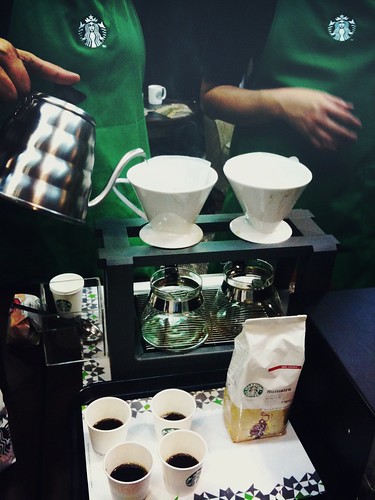
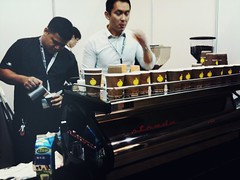
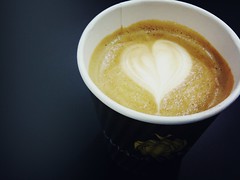
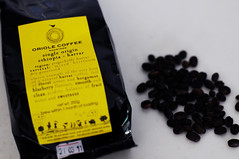

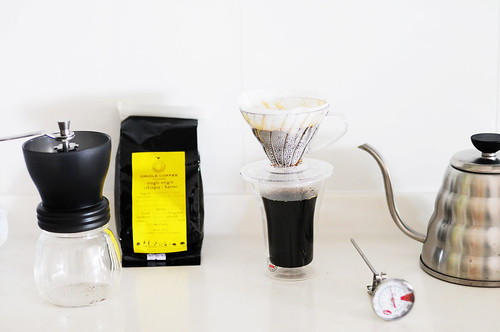
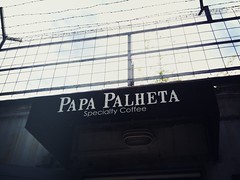
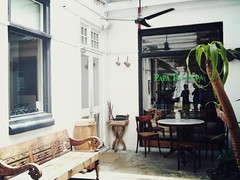
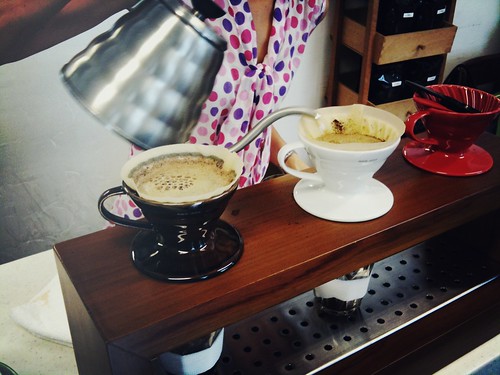
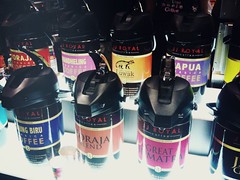
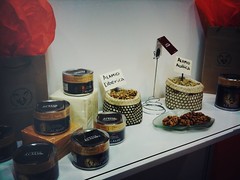








0 Comments:
Post a Comment
Subscribe to Post Comments [Atom]
<< Home